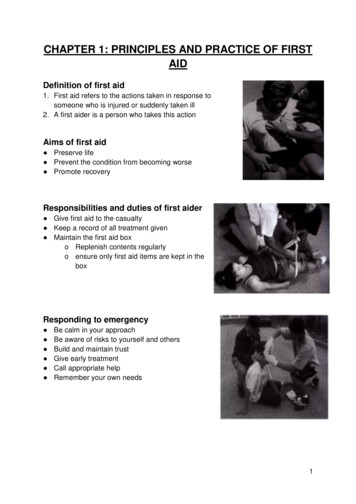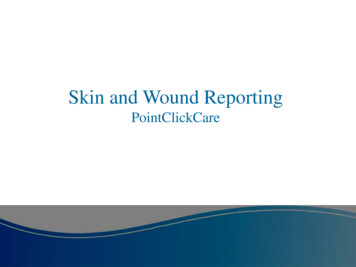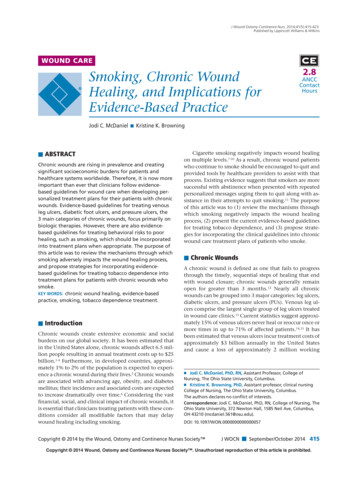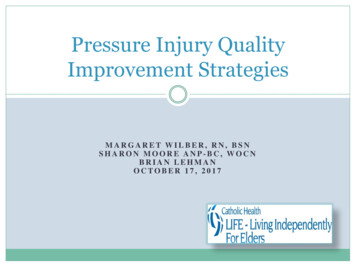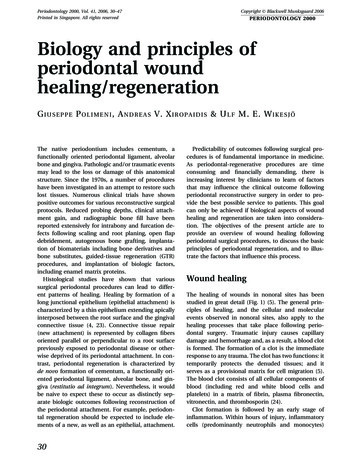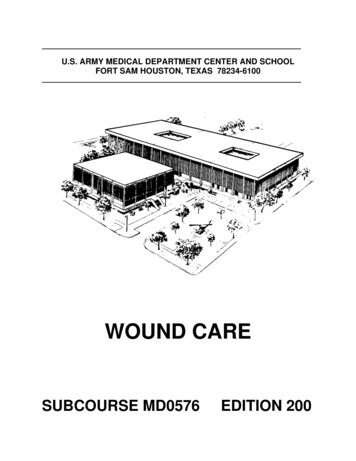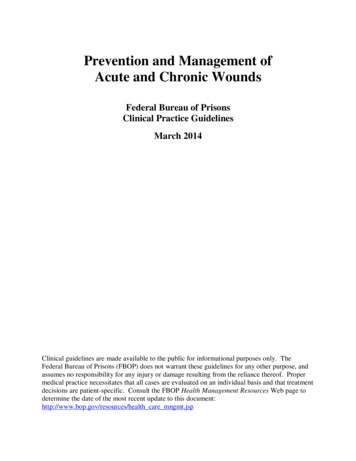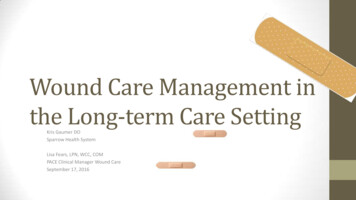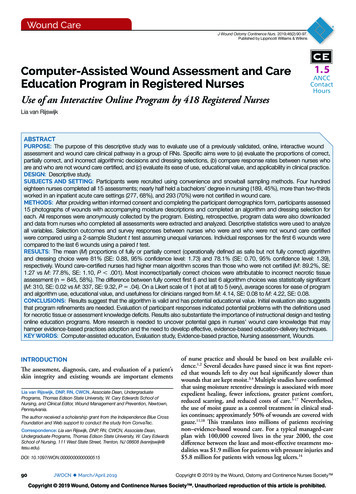
Transcription
Wound CareJ Wound Ostomy Continence Nurs. 2019;46(2):90-97.Published by Lippincott Williams & WilkinsComputer-Assisted Wound Assessment and CareEducation Program in Registered NursesUse of an Interactive Online Program by 418 Registered NursesLia van RijswijkABSTRACTPURPOSE: The purpose of this descriptive study was to evaluate use of a previously validated, online, interactive woundassessment and wound care clinical pathway in a group of RNs. Specific aims were to (a) evaluate the proportions of correct,partially correct, and incorrect algorithmic decisions and dressing selections, (b) compare response rates between nurses whoare and who are not wound care certified, and (c) evaluate its ease of use, educational value, and applicability in clinical practice.DESIGN: Descriptive study.SUBJECTS AND SETTING: Participants were recruited using convenience and snowball sampling methods. Four hundredeighteen nurses completed all 15 assessments; nearly half held a bachelors’ degree in nursing (189, 45%), more than two-thirdsworked in an inpatient acute care settings (277, 68%), and 293 (70%) were not certified in wound care.METHODS: After providing written informed consent and completing the participant demographics form, participants assessed15 photographs of wounds with accompanying moisture descriptions and completed an algorithm and dressing selection foreach. All responses were anonymously collected by the program. Existing, retrospective, program data were also downloadedand data from nurses who completed all assessments were extracted and analyzed. Descriptive statistics were used to analyzeall variables. Selection outcomes and survey responses between nurses who were and who were not wound care certifiedwere compared using a 2-sample Student t test assuming unequal variances. Individual responses for the first 6 wounds werecompared to the last 6 wounds using a paired t test.RESULTS: The mean (M) proportions of fully or partially correct (operationally defined as safe but not fully correct) algorithmand dressing choice were 81% (SE: 0.88, 95% confidence level: 1.73) and 78.1% (SE: 0.70, 95% confidence level: 1.39),respectively. Wound care–certified nurses had higher mean algorithm scores than those who were not certified (M: 89.2%, SE:1.27 vs M: 77.8%, SE: 1.10, P .001). Most incorrect/partially correct choices were attributable to incorrect necrotic tissueassessment (n 845, 58%). The difference between fully correct first 6 and last 6 algorithm choices was statistically significant(M: 310, SE: 0.02 vs M: 337, SE: 9.32, P .04). On a Likert scale of 1 (not at all) to 5 (very), average scores for ease of programand algorithm use, educational value, and usefulness for clinicians ranged from M: 4.14, SE: 0.08 to M: 4.22, SE: 0.08.CONCLUSIONS: Results suggest that the algorithm is valid and has potential educational value. Initial evaluation also suggeststhat program refinements are needed. Evaluation of participant responses indicated potential problems with the definitions usedfor necrotic tissue or assessment knowledge deficits. Results also substantiate the importance of instructional design and testingonline education programs. More research is needed to uncover potential gaps in nurses’ wound care knowledge that mayhamper evidence-based practices adoption and the need to develop effective, evidence-based education-delivery techniques.KEY WORDS: Computer-assisted education, Evaluation study, Evidence-based practice, Nursing assessment, Wounds.INTRODUCTIONThe assessment, diagnosis, care, and evaluation of a patient’sskin integrity and existing wounds are important elementsLia van Rijswijk, DNP, RN, CWCN, Associate Dean, UndergraduatePrograms, Thomas Edison State University, W. Cary Edwards School ofNursing, and Clinical Editor, Wound Management and Prevention, Newtown,Pennsylvania.The author received a scholarship grant from the Independence Blue CrossFoundation and Web support to conduct the study from ConvaTec.Correspondence: Lia van Rijswijk, DNP, RN, CWCN, Associate Dean,Undergraduate Programs, Thomas Edison State University, W. Cary EdwardsSchool of Nursing, 111 West State Street, Trenton, NJ 08608 (lvanrijswijk@tesu.edu).DOI: 10.1097/WON.000000000000051590JWOCN ¿ March/April 2019 of nurse practice and should be based on best available evidence.1,2 Several decades have passed since it was first reported that wounds left to dry out heal significantly slower thanwounds that are kept moist.3,4 Multiple studies have confirmedthat using moisture retentive dressings is associated with moreexpedient healing, fewer infections, greater patient comfort,reduced scarring, and reduced costs of care.5-17 Nevertheless,the use of moist gauze as a control treatment in clinical studies continues; approximately 50% of wounds are covered withgauze.11,18 This translates into millions of patients receivingnon–evidence-based wound care. For a typical managed-careplan with 100,000 covered lives in the year 2000, the costdifference between the least and most-effective treatment modalities was 1.9 million for patients with pressure injuries and 5.8 million for patients with venous leg ulcers.14Copyright 2019 by the Wound, Ostomy and Continence Nurses Society Copyright 2019 Wound, Ostomy and Continence Nurses Society . Unauthorized reproduction of this article is prohibited.
van RijswijkJWOCN ¿ Volume 46 ¿ Number 2Research examining barriers to implementing evidencebased practice (EBP) in wound care is limited. Existing evidence strongly suggests that organizational factors such as lackof time and resources and product barriers such as confusionsurrounding dressing categories and confusion applying careguidelines negatively influence delivery of optimal care.19-28In addition to these factors, personal/end-user barriers suchas lack of knowledge and awareness of evidence-based (EB)wound care practices and wound assessment are problematic.19-21,25,28-33 The roots of some of these problems can be tracedto basic nursing education; studies in the United States haveshown that prelicensure nursing education programs generally provide insufficient wound care education.19,25 Nursingtextbooks must cover a wide array of topics within skin andwound care chapters and descriptions of wound assessmentand related optimal dressing selections may not be included.34-37 Rather, illustrations and descriptions of gauze-baseddressings and dressing techniques remain common, andnursing student experience with non–gauze-based dressingsis limited. In 1 study when second-year nursing studentswere asked to select the best practice option for wound care,fewer than 15% selected the correct response based on principles of moist wound healing.25 Evidence further suggeststhat limited knowledge about EB wound care may carry overinto practice. For example, when provided the ability to usean EB wound assessment and dressing selection program,nurse respondents indicated that they reserved this optionfor “more serious” wounds because they believed that moistwound healing strategies should be reserved for deep and/orcomplicated wounds.38 While a change in knowledge is notsufficient to change practice, it is a prerequisite to change behavior.39 Studies in several countries outside the United Statesalso support the need for expanding wound care educationfor nurses.19,20,40-42Online education may be an efficient method for reachingmillions of RNs but the effect of online education on nurses’knowledge about wound assessment and EBPs has not beenexamined. A study of 56 certified wound care nurses foundthat completion of an online, interactive, wound care programsignificantly increased the percentage of correct and partiallycorrect algorithmic decisions; participants also recommended use of the program in nurses without expertise in woundcare.43 Based on literature review, the authors concluded thatlearner satisfaction with online programs is generally good andknowledge is increased but few high-quality studies have beenconducted to determine its effectiveness.44,45 Computer-basededucation is increasingly used in higher education and healthcare organizations to replace or supplement face-to-face continuing education programs.45,46 While literature about theeffects of computer-based learning in nursing may be limited,it is well established that guided learning, using tools that areinteractive and engage the user are particularly useful for adultlearners.47The purpose of this descriptive study was to evaluate a previously validated,43 online, interactive wound assessment andwound care clinical pathway in RNs. Specific aims were to (a)evaluate the percentages of correct, partially correct (safe but notfully correct), and incorrect algorithmic decisions and dressingselections, (b) compare algorithm and dressing selections between nurses who are and who are not wound care certified, and(c) evaluate its ease of use, educational value, and applicability inclinical practice.91METHODSThe online, interactive program used in this study was basedon Merrill’s48 first principles of instructional design; it containsa set of 8 wound care algorithms (Solutions Wound Care Algorithms, ConvaTec, Bridgewater, New Jersey). The onlineprogram has undergone extensive content and construct validity testing.20,38,49,50 The program comprises introduction slidesabout the algorithms (Figure) and how to use the program, followed by 15 wound scenarios. Participants select a care pathway/algorithm and appropriate dressing(s) for each wound based ona photograph and description of moisture in the wound bed.Participants are also able to learn more about each decision pointby clicking a “Further Reading” button. Feedback is providedafter the learner completes all exercises via a cumulative scoremeasuring the proportion of correct or partially correct responses. Scores vary from 0 to 100 and higher scores indicating morecorrect responses. Responses are scored as correct, partially correct (operationally defined as safe but not fully correct), or incorrect. In addition to their cumulative scores, respondents mayreview partially correct of incorrect choices and print a certificateof completion. Construct validity of the online program was established following testing by 56 expert wound care nurses.43SampleThe target population was licensed health care professionals practicing in the United States. Convenience and snowball samplingmethods were used to prospectively recruit participants, and alllicensed health care professionals practicing in the United Stateswere eligible to participate. However, analysis for this study waslimited to data from RN participants. Potential participants hadto confirm that they were practicing licensed health care professionals before being able to create a username and password toaccess the program. All participants provided written informedconsent by clicking on the “opt-in/yes” button and were encouraged to print a copy of the consent form for their records.Retrospectively analyzed data were collected under institutional review board approval from La Salle University Schoolof Nursing. West Chester University institutional review boardapproval was obtained for prospective data collection. All datawere collected anonymously by the program on a separate secure, password-protected server on the World Wide Web. Participants were not asked to provide their name or any personalinformation (eg, e-mail address) at any time. All demographic,user survey, and exercise result variables were coded for exportinto Excel software (Microsoft, Redmond, Washington). I didnot collect IP addresses; rather, participants received a uniqueuser ID after creating a user account. This ID was not connectedto any user-identifiable information but was needed to enableparticipants to log back in to their own program. I collected andanalyzed all study data under an agreement with the sponsoringorganization (ConvaTec, Bridgewater, New Jersey) that provided IT support during the prospective data collection phase.Study ProceduresAfter providing informed consent, participants were asked to complete the demographics and practice setting questionnaire. Demographic and practice environment variables included gender, age,wound care certification, level of highest education, years of clinicalexperience, approximate number of patients with wounds per year,primary practice site, and state in which they practice. User choicesof wound assessment and dressing(s) selection variables/algorithmCopyright 2019 Wound, Ostomy and Continence Nurses Society . Unauthorized reproduction of this article is prohibited.
92JWOCN ¿ March/April 2019www.jwocnonline.comFigure. Introduction to the online assessments.steps were recorded by the program that was coded to record choices as correct or partially correct. Partially correct was operationallydefined as an algorithm/assessment or treatment choice deemedsafe but not optimal. After completing the exercises, participantswere asked to complete a 4-item survey that queried ease of use ofthe computer program, ease of use of the algorithm, educationalvalue, and applicability in clinical practice. Responses were basedon a rating scale of 1 (indicating not at all) to 5 (indicating very).All variables, including the number of participants who opted outof the study, were recorded by the program.ercises including 418 RNs who comprised the sample for thisstudy. The average age of nurse participants was 46 years (SE:0.54, median: 47.5) and the majority (368, 88%) were female(Table 1). One hundred nine (26%) had received formal woundcare education and were certified in wound care. The majority(77, 70%) were certified by the Wound Ostomy ContinenceNursing Certification Board (eg, certified wound ostomy carenurse, certified wound care nurse, or certified WOC nurse).Most nurses (277, 66%) practiced in an inpatient acute caresetting located in the North Eastern area of the United States.Data AnalysisAlgorithmic Decisions and Dressing SelectionResponse RatesData from all nurses who consented to participate and completed all 15 wound assessments were extracted from the dataset and included in the analysis. Practice site and state datawere grouped by geographic region and individual algorithmand dressing choices were coded. Descriptive statistics wereused to analyze the demographic, survey, and algorithm anddressing selection outcomes variables. A 2-sample Student t testassuming unequal variances was used to compare algorithmand dressing selection outcomes and survey responses betweennurses who were and nurses who were not wound care certified.Individual correct algorithm selections for the first 6 woundswere compared to the last 6 wounds using a paired t test.RESULTSFour hundred twenty health care professionals agreed to participate prior to the prospective data collection phase and 119agreed during the 3-month prospective data collection period.Four hundred fifty-one participants (84%) completed all ex-Based on photographs and moisture descriptions, the mean proportion of fully correct selections was 77% (SE: 1.09, 95% confidence level [CL]: 2.14). When partially correct choices wereadded, the proportion rose to a mean of 81% (SE: 0.88, 95%CL: 1.73, range: 13.3%-100%). The percent fully and partiallycorrect dressings(s) choices were 78.1% (SE: 0.70, 95% CL:1.39) and 0.5% (SE: 0.16, 95% CL: 0.31), respectively, for atotal 78.6% (SE: 0.71, 95% CL: 1.40, range: 20%-100%). Themean proportion of correct/partially correct algorithm choices was significantly higher for nurses certified in wound careversus those who were not (M: 89.2, SE: 1.27 vs M: 77.8, SE:1.102; t 6.76, P .001). Similarly, correct dressing selectionscores were significantly higher for nurses who were, comparedto nurses who were not wound care certified (M: 84.2, SE: 1.18vs M: 76.6, SE: 0.86; t 5.15, P .001) (Table 2).Of the 6270 algorithm choices made, an incorrect amountof wound moisture was selected 353 times (6%) and in 250instances (4%), a partially correct amount of wound moistureCopyright 2019 Wound, Ostomy and Continence Nurses Society . Unauthorized reproduction of this article is prohibited.
van RijswijkJWOCN ¿ Volume 46 ¿ Number 2(81%) for the last 6 algorithm choices. The difference betweenfully correct choices for the first compared to the last 6 algorithms was statistically significant (M: 310, SE: 0.02 vs M:337, SE: 9.32; paired t 2.05, P .04).TABLE 1.Participant Demographic and Practice VariablesVariablen (%)aGenderFemaleMale368 (88)34 (8)Wound care certificationNoYes293 (70)109 (26)Highest level of educationDiploma/ADNBSNBachelor’s degree, otherMSNMaster’s degree, otherPhD, EdD, DNP126 (30)189 (45)13 (3)51 (12)4 (1)7 (2)Years of nursing experience 3020-2910-195-90-465 (15)83 (20)104 (25)56 (13)65 (15)Primary practice siteInpatient acute careOutpatient acute careLong-term careHome careOther277 (66)37 (9)18 (4)19 (5)36 (9)Approximate number of patients with wounds per year 200150-199100-14950-990-49124 (30)35 (8)59 (14)94 (22)79 (18)Practice setting geographic regionNorth EastMidwestSouthWest277 (66)29 (7)68 (16)30 (7)93Ease of Use, Educational Value, and ClinicalApplicability Survey ResponsesOne hundred forty-four of 418 participants (24%) completedthe 4-item survey that queried ease of use and clinical applicability. The mean scores for ease of use of the online programand algorithm were 4.22 (SE: 0.08) and 4.14 (SE: 0.08), respectively, out of a possible 5 (Table 3). The mean scores foreducational value and applicability in clinical practice were4.22 (SE: 0.08) and 4.19 (SE: 0.08), respectively. Analysisrevealed no significant differences in rating scores based oncertification in wound care (P .49). Similarly, no significantdifferences based on participant wound care certification wereobserved for ease of use scores (M: 4.122, SE: 0.15 vs M: 4.16,SE: 0.1; t 0.2, P .4), educational value (P .4), clinicalapplicability (P .39) or overall usefulness (P .329).DISCUSSIONThe need for effective wound care education for nurses iswell documented, and online education may help fulfill thisneed.19,20,21,25,28,29,31,32,51,52 I evaluated responses from 418 RNs,most of whom were working in acute care facilities and did nothold wound care certification using a validated online education program and algorithm for wound assessment and dressing selection. Based on a wound photograph and descriptionof the amount of wound moisture, nurses selected a safe, EBdressing option for 15 wounds a little over 75% of the time.Participants who were wound care certified scored significantlyhigher than did nurses who were not certified. This finding andthe similarity between these results and previous studies usingthe algorithms or algorithm program provide further supportfor the construct validity of this online program.20,43Assessments and Algorithm SelectionsAbbreviations: AND, associate degree nursing; BSN, bachelor of science in nursing; MSN,master of science in nursing.aTotals do not add up to 100% for each variable due to missing values.was chosen. The remaining incorrect selections were based onan incorrect assessment of the amount of necrotic tissue inthe wound (845, 13%). Incorrect assessment of necrotic tissueresulted in the largest proportion of all partially correct andincorrect responses (n 1448, 58%).The number of correct algorithm selections for the first6 algorithms (n 2508) was 1860 (74%) compared to 2023The most common areas associated with partially correct andincorrect responses were related to amount of moisture andpresence of necrotic tissue. The type and amount of woundexudate (moisture) and type of tissue in the wound bed areimportant drivers of the plan of care and resultant dressing selection.5,33,53 Essential wound assessment variables that requiremonitoring and guide treatment included in the algorithmused in this online program were based on the Bates-JensenWound Assessment Tool, previously called the Pressure SoreStatus Tool.20,53-55 To provide EB wound care and maintain amoist wound environment,5-9 a dressing that absorbs, donates,TABLE 2.Algorithm and Dressing SelectionAll Participants (N 418)OutcomeWound Care Certified (n 109)Not Wound Care Certified (n 293)Mean % (SE)95% CLMean % (SE)95% CLMean % (SE)95% CLPaCorrect and partially correct algorithmchoices81 (0.88)1.7389.2 (1.27)2.5377.8 (1.1)2.17 .001Correct and partially correct dressing(s)choices78.6 (0.71)1.484.2 (1.18)2.3576.6 (1.71)1.71 .001Abbreviations: CL, confidence level; SE, standard error.aTwo sample t tests assuming unequal variances wound care certified compared to not wound care certified.Copyright 2019 Wound, Ostomy and Continence Nurses Society . Unauthorized reproduction of this article is prohibited.
94JWOCN ¿ March/April 2019www.jwocnonline.comTABLE 3.Survey Results (n 144)QuestionMean (SE)a95% CLOverall ease of using computer program itself4.2 (0.08)0.17Overall ease of using algorithms4.14 (0.08)0.17Educational value for clinicians4.22 (0.08)0.16Overall usefulness for clinicians4.19 (0.08)0.17Abbreviations: CL, confidence level; SE, standard error.aScale 1 (not at all) to 5 (very).or maintains moisture must be selected based on the assessedamount of exudate. Because the amount of wound moisturecannot be ascertained from a photograph, this informationwas provided in a text box. Nevertheless, 10% of the 6270algorithm selections differed from the information provided.While it is possible that participants decided to override given answer because they did not agree with the stated level ofmoisture in the text box, I believe it much more likely that participants simply did not see or read the text. Because framing isan important component of computer-based learning tools,56each screen contains a visual of the algorithm pathway andselections made in addition to the wound photograph itselfand a decision selection box (Figure). Whether this combination resulted in too much information on the screen itself isunknown. Alternatively, the text font size or color may be lessthan optimal, resulting in learners failing to include moistureinformation into subsequent decisions.56 This finding is animportant reminder about the importance of testing computer-based learning programs using large samples of end-users.The potential design error on this screen was not evident untilthe program was tested by hundreds of nurses.Assessment of the presence and amount of necrotic tissue( 25% or 25%) is essential because it determines the needfor wound debridement. In this study, an incorrect necrotictissue assessment was made 845 times (13%) accounting forthe largest proportion (58%) of partially correct or incorrectwound care path/dressing choices.Detailed information about which aspects of the wound assessment process are most challenging for nonexpert nurses aswell as data about the validity and reliability of most woundand pressure injury assessment instruments is limited.57 Information about health care professionals’ ability to assess woundnecrotic tissue is also sparse and shows considerable variation.One study evaluated the inter- and intrareliability of 4 assessors using a photographic wound assessment instrument with95 wound photographs. After completing training on use ofthe instrument, the intrarater reliability for amount of necrotictissue ranged from 0.65 to 0.90 and the interrater reliability for this variable was 0.70.58 In another study, intraratervariability for assessing percentage of devitalized tissue by adermatologist and dermatology residents in 31 wounds was15%.59 Terris and colleagues60 asked 2 wound care nurses toassess 31 wounds in 15 patients. Interrater agreement was fairfor the presence of yellow or brown tissue with slough andsubstantial for the presence of eschar. When Buckley and colleagues21 asked 33 home health care nurses to assess 10 woundphotographs, they found an 85% average correct rating for thepresence of slough and a 92% correct identification of eschar.The small sample size of these studies may have contributed to the observed variability but, as noted by Buckley andcolleagues,21 misunderstanding about terminology also mayhave influenced results. Concerns about the validity and reliability of commonly used wound terms, identified many yearsago, have not been resolved.49 Wound assessment descriptionsand mnemonics have been developed with limited, if any,testing.57 When originally tested using the Pressure Sore StatusTool instrument, neither necrotic tissue type nor amount hadlow inter- or intrarater reliability scores54 and the total item correlation for these items was 0.73 when translated and tested by102 nurses in Turkey.61 Moreover, the Content Validity Index ofthe necrotic tissue amount item in these algorithms was morethan 0.8 when rated by expert as well as nonexpert nurses in2 studies.20,49 However, Beitz and van Rijswijk20 evaluated thealgorithm used in this educational program and reported thatthe proportion of correct choices made by nonexpert nurses forwounds with necrotic tissue was much lower than the proportion correct for wounds without necrotic tissue (average 59% vs80%). Similarly, in this study, the percentage of correct/partiallyalgorithm choices, based on wound moisture level and necrotictissue assessment, was significantly lower for nonexpert than forwound expert nurses. Therefore, I assert that classification andassessment of wound necrotic tissue should be an importantcomponent of wound education programs. I also believe thatit is important to educate nurses using classification and assessment terminology that has been shown to be valid and reliable.Computer-Based LearningComputer-based learning is increasingly used by health careand educational organizations,45,46 but many computer-basedlearning programs consist of digitized text and photographs.The first of Merrill’s48 4 principles of instructional design holdsthat learners should be engaged in solving real-world problems. Evidence suggests that situational or problem-based interactive e-learning is an effective method to improve novicelearners’ performance, and interactive education has a morepositive effect on improving EBP than didactic education.62-64Learning outcomes were not assessed in this study but thedifference between fully correct choices for the first comparedto the last 6 wounds was statistically significant (74% vs 81%).While a difference is to be expected as a result of a naturalprogram learning curve, the statistical significance of the difference suggests that participant learning occurred. In the previous study using these algorithms, the percentage of correctand partially correct algorithm choices increased only slightly,but the difference was statistically significant.20Interactive technologies are generally well received by nurses and are consistent with principles of adult learning theory.47,65 The online educational program evaluated in this studywas rated highly for ease of use as was the algorithm withinthe program (average scores 4.1 on a scale of 1-5). Bothwound care–certified and nonexpert nurses indicated that theprogram was valuable for education and applicable to clinicalpractice (mean and mode scores were 5 for both items in bothgroups). I acknowledge that the response rate to the survey wasrelatively low (24%). This outcome may have been influencedby the placement of the survey within the program. It wasplaced at the end of the exercises and next to a summary ofthe algorithm and outcomes. It was also placed below a boxenabling the participant to print a certificate of completion.After downloading the certificate, participants may not havereturned to that last window or they did not see the surveyoption because they focused on the results.Copyright 2019 Wound, Ostomy and Continence Nurses Society . Unauthorized reproduction of this article is prohibited.
van RijswijkJWOCN ¿ Volume 46 ¿ Number 2LimitationsMany participants did not complete all exercises and the reasons for failing to complete the program are not known. Participants were able to complete the exercises during a secondsession but, in order to ensure confidentiality, usernames werenot collected by the program. Therefore, the program couldnot retrieve the participant’s username if forgotten when attempting to log in and complete the exercises. Not knowingwhy participants failed to complete all exercises is a limitationof this study and may have biased the results.The geographic distribution of study participants heavily favored the North East region of the United States, mostlikely due to the sampling method used and my geographiclocation. This disproportion in the distribution in participantsmay affect the external validity of findings. In addition, theavailability of the Web site was not widely promoted and external incentive for nurses to participate was not provided. Theinfluence of these factors on the external validity of the studyis not known.IMPLICATIONS FOR PRACTICE AND RESEARCHIncreased emphasis on the quality (and testing) of clinicalguidelines, simple guideline tools, decision aids, and computerized clinical support systems may increase adoption of EBwound care practices.5,64,66 However, as shown in the studiesusing these algorithms, any necessary changes must be carefully considered and tested to maintain instrument validity.Study findings suggest that RNs enjoy interactive e-learning,and it exerts a positive effect on learning, which may improveEBP. The program used in this study incorporated Merrill’s48 firstprinciples of instructional design, facilitating the immediate application of new knowledge. The nurse participants possess someknowledge related to wound assessment and care; the photographs activated that knowledge while the algorithmic pathwaysprovided visual maps and crucial relationships supporting clinicaldecision making.43 Interactive e-learning programs also may beused to help nursing s
Undergraduate Programs, Thomas Edison State University, W. Cary Edwards School of Nursing, 111 West State Street, Trenton, NJ 08608 (lvanrijswijk@ tesu.edu). Computer-Assisted Wound Assessment and Care Education Program in Registered Nurses Use of an Interactive Online Program by 418 Registered Nurses Lia van Rijswijk DOI: 10.1097/WON .
